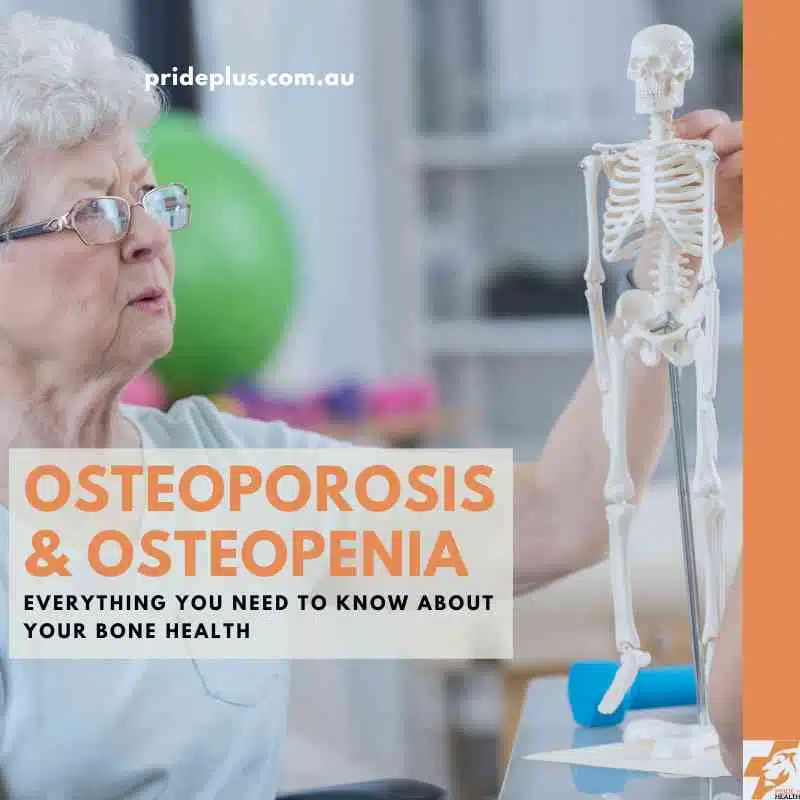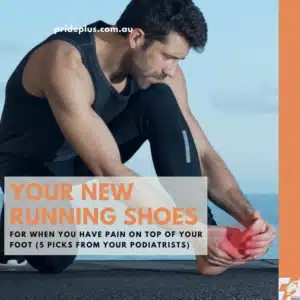My mum always used to say that having osteoporosis was having “bird bones” and at any minute she could float away, but had to be careful how she would land.
Well, it’s not quite that simple.
Mum never did float away but she did hit the deck hard and has fractured her fair share of bones. And this all relates to osteoporosis and osteopenia.
For many, it starts with osteopenia. This is where your bones aren’t as dense or strong as you would usually expect for your age. Think of it as a precursor and early warning sign. If you’ve been told you have osteopenia it’s a good idea to act on what you can change, to stop or slow its progression to osteoporosis.
This brings us to the big one, OP. Osteoporosis.
OP is considered a chronic disease, a long-term condition where your bones are more easily broken. They become fragile, lose density and are susceptible to both stress and acute fractures.
Causes of Osteoporosis
You are more likely to develop osteoporosis if you are physically inactive, have a poor diet, smoke and drink too much.
But you probably already knew that these things were not good for your health. Also, there are plenty of people who do all of these and yet don’t develop osteoporosis.
So what gives?
There are a whole bunch of risk factors that are linked with developing osteoporosis. Some you can change, and some you can’t. Those mentioned above, can all be changed (yes, we’re saying that you CAN quit smoking – despite how difficult it will be). Then, there are the ones that can’t.
If you’re female, over 70, have gone through early menopause or had family members have hip fractures in the past you’re more likely to get osteoporosis.
When you think of these risk factors it’s all a calculation. The more of them that you have or are behaviours you exhibit, the more likely you are to get osteoporosis. Also, the more severe your osteoporosis is likely to be.
Causes of Osteopenia
As you are now familiar with osteopenia being a precursor or early warning sign of osteoporosis, it will make sense that the same risk factors for developing osteoporosis are the causes of osteopenia.
Risk Factors For Osteoporosis
There are some risk factors you can change, and others you can’t that increase your likelihood of developing osteoporosis. Some diseases are linked with the development of osteoporosis due to the disease itself or the side effects of medication required to manage it.
Modifiable Risk Factors
- physical inactivity
- low muscle mass (poor strength)
- smoking
- high alcohol intake
- poor diet (inadequate calcium & vitamin D)
- low body weight
Non-Modifiable Risk Factors
- a family history of hip fractures
- being female
- early menopause
- age greater than 70 years
Diseases and Medications Linked with Osteoporosis
- steroids (long-term use of more than 3 months)
- thyroid hormone replacement
- antidepressants
- anti-reflux medications (proton pump inhibitors)
- chronic kidney and liver disease
- coeliac disease
- rheumatoid arthritis
- hyperthyroidism
How Osteoporosis is Diagnosed
In Australia osteoporosis is usually diagnosed by your GP.
When you have your routine health check-ups with your doctor if you exhibit a bunch of those risk factors above your doctor will likely open the discussion with you about getting a DEXA scan. A dual-energy absorptiometry scan (DEXA for short) is a type of x-ray that measures the density of your bones at a couple of specific locations.
From there, the scan (and radiologist) will tabulate a T-Score which is a measure of your overall bone density. A T-score less than -2.5 indicates osteoporosis. On this test, just like your year 9 maths exam you want to get a high score. The bigger the number, the stronger your bones are.
Symptoms of Osteoporosis and Osteopenia
The reason your GP will open the conversation with you to get a DEXA scan to diagnose your osteoporosis is that you won’t know that you have it.
That’s one of the fascinating aspects of OP.
You don’t know you have it. There aren’t any symptoms, particularly early on when it’s mild osteoporosis or only osteopenia.
In severe cases of osteoporosis which are all likely to be post-diagnosis in Australia, you can start to get symptoms if you develop stress fractures in your bones. In these cases, the ache of a stress fracture is not so much a symptom of osteoporosis – but a secondary injury that occurs because of the OP.
Treatment of Osteoporosis in Australia
We’re incredibly lucky in Australia to have a wealth of treatment options for osteoporosis and osteopenia.
These treatments are all lined up to address some of the modifiable risk factors as well as a couple of medications that can increase bone density.
Exercises for Osteoporosis
When you have osteoporosis some exercises are more important than others.
If you fall, you’re more likely to fracture a bone, so you need to exercise to work on your muscle strength and balance. Also, resistance training and high-impact loading signal your body to build more bone. Cardio exercises are also important so you can dip into different training zones to do your high-impact exercises.
I’m lucky to work with incredible exercise physiologists (exercise experts) who have not only helped my Mum with her bird bones, I’ve overheard plenty of great explanations for how to get the right exercise done for you and your bones.
Exercises for Osteopenia
The exercises you need to do to improve your osteopenia are the same as the ones when you have osteoporosis.
The dosage might change, and you might be doing higher intensity, volume or load exercises when your bones are only osteopenic and not osteoporotic. But the rationale and type of exercises are the same.
- high intensity for improving bone growth.
- resistance training for muscle, joint and bone strength and flexibility.
- balance training to reduce your risk of falls.
Medications for Osteoporosis
The most common medications prescribed for osteoporosis in Australia are Bisphosphonates (tablets called Fosamax or similar) and an injection of Denosumab (called Prolia).
There are also less common medications that include;
- MHT (menopause hormonal treatment)
- SERMs (selective estrogen receptor modulators)
- Teriparatide
Supplements for Osteoporosis
How are we only getting to calcium and vitamin D now?
It’s been drummed into us since we were all little kids, you need milk for calcium for strong bones… Well, you don’t necessarily need the milk (with apologies to my dairy farming friends and family), but you do need the calcium and vitamin D.
Calcium is the building block of healthy bones and vitamin D is vital to absorbing and putting your calcium to good use.
Mostly you’ll get your vitamin D from sun exposure however in Australia we’re so active in trying to reduce our skin cancer risk by slip, slopping and slapping we might not be getting enough vitamin D. You can top up your vitamin D levels without increasing your skin cancer risk by taking supplements and eating food which is rich in vitamin D.
Foods that are good sources of vitamin D:
- oily fish (salmon)
- liver
- eggs
And back to calcium. Your dairy products (milk, cheese, yoghurt etc) are all high in calcium but you already knew that. If you’re vegan or not that interested (or your stomach doesn’t tolerate) dairy you’ll also find plenty of calcium in the following foods.
- sardines or salmon (with bones)
- spinach
- almonds
If you’re at risk of not getting enough calcium you can take supplements as well. All Australian adults are recommended to consume 1,000mg of calcium per day, and those at risk (again, men and women over 70 and post-menopausal women) need to get 1,300mg of calcium.
While dietary intake and getting the right amount of healthy sun exposure is best, taking supplements is a surefire way for you to easily get the amount of calcium and vitamin D you need. Although they still haven’t made a tablet as tasty as sardines on toast!
Osteoporosis FAQ
Bones are living tissue; they grow throughout our lives and then slowly break down when we die. Bone loss occurs naturally with aging but also may be accelerated by certain diseases or medications.
To maintain bone strength, you need to consume enough calcium and vitamin D along with regular weight-bearing and resistance exercise.
Avoid smoking, drinking to excess and try to build a great relationship with the foods and activities that will help you maintain healthy bones. That way, it won’t be a chore for you to exercise and eat the foods you need to.
Osteoporosis is generally underdiagnosed because there are no obvious signs or symptoms. However, once osteoporosis is detected, it is usually too late to prevent fractures. In Australia, approximately one in three women and one in five men aged 50 years and older will experience a fragility fracture during their lifetime.
The most commonly affected bones include the spine, hip, wrist and forearm. A fragility fracture typically causes pain, loss of height and deformity. Osteoporosis affects both sexes equally; however, women are twice as likely to sustain a fracture due to osteoporosis compared with men.
In addition to being associated with an increased risk of fracture, osteoporosis increases the likelihood of falls and subsequent injury. Falls are the leading cause of fatal injuries among older adults.
Osteoporosis affects millions of people worldwide; however, it disproportionately impacts women. In fact, according to the National Osteoporosis Foundation, one out of every three women over 50 will develop some form of bone loss during her lifetime.
But this doesn’t mean blokes are in the clear.
Men are less likely to experience osteoporosis but several risk factors can put men at greater risk of developing osteoporosis.
– Chronic diseases that affect the kidneys or lungs, stomach or intestine, or alter hormone levels.
– Regular use of steroid medications which are used to treat asthma and arthritis
– Unhealthy habits, including smoking, excessive alcohol use and low dietary calcium intake
Osteoporosis is not inherited; however, some people are at greater risk for developing this condition due to certain genetic factors. There’s a link, but it’s not a guarantee that if you’re mother or father had osteoporosis, you will too.
During menopause, the ovaries stop producing estrogen, a hormone that helps keep bones strong. Over time, this loss of estrogen leads to thinning of the bones.
About the Author

Tim Mulholland is a Melbourne podiatrist and La Trobe University Clinical Educator. He’s passionate about physical activity and helping you lead your best, most active life. Like many readers, Tim has experienced first hand the loss of a loved family member after a fracture from a fall. Understanding osteoporosis and improving strength and balance is somewhat of a mission.




